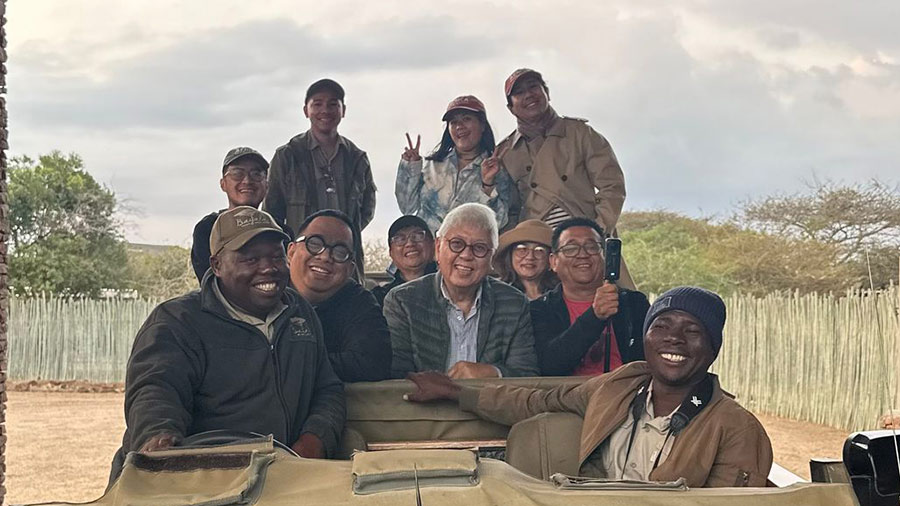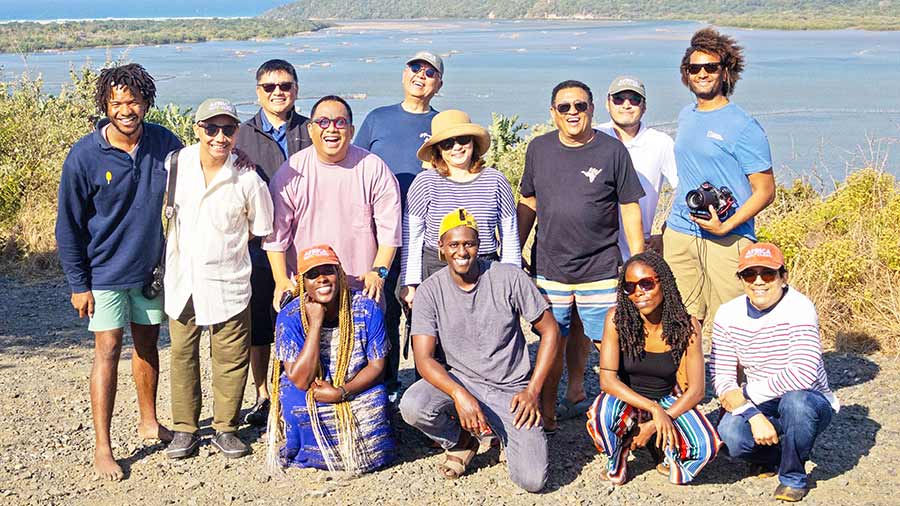‘That whoever we are and wherever we come from, we are made up of atoms, but life is only lived and perceived through stories’
Last week, after spending almost two and a half hours queuing at the Immigration Booth at NAIA Terminal 3 and enduring nearly six hours of layover in Dubai, we were finally off to South Africa – truly a trip of a lifetime.
We asked the head of our delegation, Maribel Garcia, how the program “Africa to Archipelago” came about and what its main objectives were.
She explained, “‘Africa to Archipelago’ was a convergence of many things. First, a biodiversity musical has always been on the horizon for us, as Bonifacio Global City (BGC) and the Bonifacio Art Foundation Inc (BAFI) – which conceived and operates The Mind Museum and the BGC Arts Center – are both an art and science foundation. Second, both The Mind Museum and the BGC Arts Center have always prioritized partnerships in terms of innovating and shapeshifting to co-create stories that can shape our better selves and create diverse futures for Filipinos. Third, we started a project with scientist/artist Cesar Harada and community partners to imagine what an International Oceans Station would be like if the voices of fisherfolk were heard. These efforts attracted the National Geographic Society (NGS) as they resonated with their Storytellers Collective – a movement from many parts of the world to reframe the way we have been crafting narratives about the way we live. And it becomes even more crystallized when patterns emerge.”
 National Artist Ryan Cayabyab recounts other memorable activities: “A morning lecture and storytelling workshop were given by Jahawi Bertolli from the National Geographic Storytellers Collective. We felt like we were taking a doctorate-level subject, but it was so much fun because the setting was very informal. Then we had a Drum Circle and a music jam session afterward.”
National Artist Ryan Cayabyab recounts other memorable activities: “A morning lecture and storytelling workshop were given by Jahawi Bertolli from the National Geographic Storytellers Collective. We felt like we were taking a doctorate-level subject, but it was so much fun because the setting was very informal. Then we had a Drum Circle and a music jam session afterward.”
Events director and technical head Rjho Dee, although lost for words, is excited to see where this will all lead us. Always on the go, he reports: “On our last day in KZN, we had a quick trip to Hluhluwe-Imfolozi Park and learned about their conservation efforts for the white rhinoceros. By the 1940s, there were only 40 white rhinos left on Earth, but after almost a century of intense conservation efforts, there are now around 19,000 to 21,000 in South Africa. HIP is the oldest proclaimed reserve in Africa, with 96,000 hectares of steep hills and wide, deep valleys.”
What are the lessons learned from the one-week Storytelling Collective and immersion session in South Africa?
“That whoever we are and wherever we come from, we are made up of atoms, but life is only lived and perceived through stories; that you change the story once you change the storyteller; and that art and science together make for whole stories that address our fuller humanity,” said Maribel, who has listed these as part of her core memory. “Wondering why we were invited to snorkel in the lake with humongous hippos in our midst (kidding!).
Whether it was our nature drives, the structured and free-ranging conversations, the musical jams, the wonderful meals, the endless singing, or the resounding chuckles and laughter – they all helped to create an indelible mark of life that now moves inside my mind. And that inspires me to help move it forward with the team in imaginative ways.
Even more, there was a widely shared feeling of growing and being enriched together–an expansive direction as opposed to experiences that make you cave in. We will craft the musical story of who we are as Filipinos, celebrating and pledging to work with nature, with all of our unique foibles and strengths. It is that singular chance we will seize with all our might!”
This is a 3-year project that began with that trip to South Africa. We have just started to frame the collaboration. The great thing about this project is that there are no predetermined formats for what we will produce. We are free to recruit all kinds of creative formats that will genuinely tell the stories we need to tell.
This November, the NEWF team, which consists of fellows not only from South Africa but also from other African countries, will visit the Philippines, where we will work in Palawan with scientists, communities, park rangers, indigenous peoples, and forest communities to start weaving the story.
Esteemed conservationist and academic Dr. Neil Aldrin Mallari summed up his learning as well: “South Africa Refocusing: In the midst of the vast landscape, nature’s tapestry, and biophony, one needs to focus, conserve one’s energies, resources, and life force to achieve greater impact, to create that safe operating space for nature and people. Together we continue changing the story, changing the narrative, and changing the storyteller–all for the common good!”





